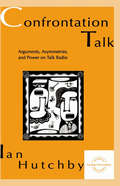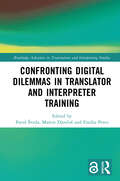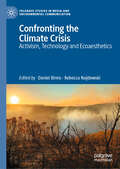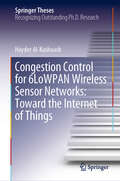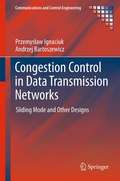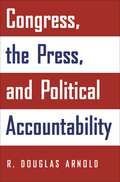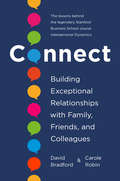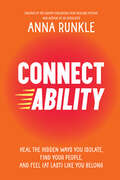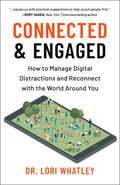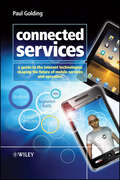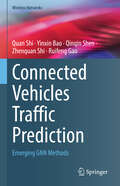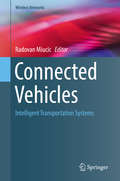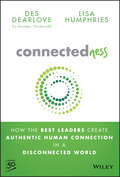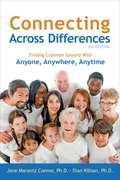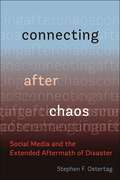- Table View
- List View
Confrontation Talk: Arguments, Asymmetries, and Power on Talk Radio (Everyday Communication Series)
by Ian HutchbyUsing conversation analysis to explore the nature of argument, asymmetry, and power on talk radio, this book focuses on the interplay between the structures of talk in interaction and the structures of participation on talk radio. In the process, it demonstrates how conversation analysis may be used to account for power as a feature of institutional discourse. To address a number of key issues in the study of institutional communication and conflict talk, a case study of a British talk radio show is presented, stimulating some penetrating questions: * What is distinctive about interaction on talk radio? * What is the basis of the communicative asymmetries between hosts and callers? * How are their arguments constructed, and in what ways does the setting enable and constrain the production of conflict talk? These questions are answered through the detailed study of conversational phenomena, informed by a critical concern for the relationship between talk and social structure. This book will be of interest to a wide readership consisting of academics, advanced undergraduates, and postgraduate students in a range of courses in sociology, linguistics, media/communication/cultural studies, anthropology, and popular culture.
Confronting Digital Dilemmas in Translator and Interpreter Training (Routledge Advances in Translation and Interpreting Studies)
by Pavol ŠvedaThis collection explores the challenges and opportunities brought on by developments in emergent technologies for translator and interpreter training.Given the growing role of language professionals as mediators in an increasingly fragmented and globalized world, this book offers an in-depth look at the present and future of translator and interpreter training amidst these changes. Featuring perspectives from established and up-and-coming scholars, the volume is organized in three sections taking in turn different dimensions of the current training landscape. These parts consider key topics including theoretical foundations and pedagogical innovations, ethical considerations and social responsibility, and ways forward for adapting training programs to better grapple with new tools.Taken as a whole, this book will be a useful resource for students and scholars in translation and interpreting studies, as well as practicing professionals.
Confronting the Climate Crisis: Activism, Technology and Ecoaesthetics (Palgrave Studies in Media and Environmental Communication)
by Daniel Binns Rebecca NajdowskiThis collection examines how activism, media, and creative practices shape our understanding of the climate crisis. Bringing together perspectives from media studies, environmental humanities, and artistic research, Confronting the Climate Crisis: Activism, Technology and Ecoaesthetics explores how digital technologies, protest movements, and ecoaesthetic interventions influence ecological discourse. Fifteen chapters interrogate a range of case studies, from student activism and climate-related art to the role of video games, memes, and machine learning in framing and comprehending environmental collapse. The collection also considers how experimental cinema, podcasts, and documentary practices can move beyond entertainment and spectacle to foster lasting and meaningful action against environmental change. Highlighting the intersections of politics, technology, and aesthetics, this book offers a vital resource for scholars, artists, and activists seeking to navigate and challenge contemporary climate narratives. It argues that creative and technological interventions are essential to rethinking our relationship with the planet and shaping new modes of ecological action.
Congestion Control for 6LoWPAN Wireless Sensor Networks: Toward the Internet of Things (Springer Theses)
by Hayder Al-KashoashThe Internet of Things (IoT) is the next big challenge for the research community. The IPv6 over low power wireless personal area network (6LoWPAN) protocol stack is considered a key part of the IoT. In 6LoWPAN networks, heavy network traffic causes congestion which significantly degrades network performance and impacts on quality of service aspects. This book presents a concrete, solid and logically ordered work on congestion control for 6LoWPAN networks as a step toward successful implementation of the IoT and supporting the IoT application requirements. The book addresses the congestion control issue in 6LoWPAN networks and presents a comprehensive literature review on congestion control for WSNs and 6LoWPAN networks. An extensive congestion analysis and assessment for 6LoWPAN networks is explored through analytical modelling, simulations and real experiments. A number of congestion control mechanisms and algorithms are proposed to mitigate and solve the congestion problem in 6LoWPAN networks by using and utilizing the non-cooperative game theory, multi-attribute decision making and network utility maximization framework. The proposed algorithms are aware of node priorities and application priorities to support the IoT application requirements and improve network performance in terms of throughput, end-to-end delay, energy consumption, number of lost packets and weighted fairness index.
Congestion Control in Data Transmission Networks: Sliding Mode and Other Designs (Communications and Control Engineering)
by Andrzej Bartoszewicz Przemysław IgnaciukCongestion Control in Data Transmission Networks details the modeling and control of data traffic in communication networks. It shows how various networking phenomena can be represented in a consistent mathematical framework suitable for rigorous formal analysis. The monograph differentiates between fluid-flow continuous-time traffic models, discrete-time processes with constant sampling rates, and sampled-data systems with variable discretization periods. The authors address a number of difficult real-life problems, such as: optimal control of flows with disparate, time-varying delay; the existence of source and channel nonlinearities; the balancing of quality of service and fairness requirements; and the incorporation of variable rate allocation policies. Appropriate control mechanisms which can handle congestion and guarantee high throughput in various traffic scenarios (with different networking phenomena being considered) are proposed. Systematic design procedures using sound control-theoretic foundations are adopted. Since robustness issues are of major concern in providing efficient data-flow regulation in today's networks, sliding-mode control is selected as the principal technique to be applied in creating the control solutions. The controller derivation is given extensive analytical treatment and is supported with numerous realistic simulations. A comparison with existing solutions is also provided. The concepts applied are discussed in a number of illustrative examples, and supported by many figures, tables, and graphs walking the reader through the ideas and introducing their relevance in real networks. Academic researchers and graduate students working in computer networks and telecommunications and in control (especially time-delay systems and discrete-time optimal and sliding-mode control) will find this text a valuable assistance in ensuring smooth data-flow within communications networks.
Congress, the Press, and Political Accountability
by R. Douglas ArnoldCongress, the Press, and Political Accountability is the first large-scale examination of how local media outlets cover members of the United States Congress. Douglas Arnold asks: do local newspapers provide the information citizens need in order to hold representatives accountable for their actions in office? In contrast with previous studies, which largely focused on the campaign period, he tests various hypotheses about the causes and consequences of media coverage by exploring coverage during an entire congressional session. Using three samples of local newspapers from across the country, Arnold analyzes all coverage over a two-year period--every news story, editorial, opinion column, letter, and list. First he investigates how twenty-five newspapers covered twenty-five local representatives; and next, how competing newspapers in six cities covered their corresponding legislators. Examination of an even larger sample, sixty-seven newspapers and 187 representatives, shows why some newspapers cover legislators more thoroughly than do other papers. Arnold then links the coverage data with a large public opinion survey to show that the volume of coverage affects citizens' awareness of representatives and challengers. The results show enormous variation in coverage. Some newspapers cover legislators frequently, thoroughly, and accessibly. Others--some of them famous for their national coverage--largely ignore local representatives. The analysis also confirms that only those incumbents or challengers in the most competitive races, and those who command huge sums of money, receive extensive coverage.
Congressional Communication in the Digital Age (Routledge Research in American Politics and Governance)
by Jocelyn Evans Jessica M. HaydenCommunication defines political representation. At the core of the representational relationship lies the interaction between principal and agent; the quality of this relationship is predicated upon the accessibility of effective channels of communication between the constituent and representative. Over the past decade, congressional websites have become the primary way constituents communicate with their members and a prominent place for members to communicate with constituents. Yet, as we move toward the third decade of the 21st century, little work has systematically analyzed this forum as a distinct representational space. In this book, Jocelyn Evans and Jessica Hayden offer a fresh, timely, and mixed-methods approach for understanding how the emergence of virtual offices has changed the representational relationship between constituents and members of Congress. Utilizing strong theoretical foundations, a broad historical perspective, elite interviews, and rich original datasets, Evans and Hayden present evidence that virtual offices operate as a distinct representational space, and they demonstrate that their use has resulted in unprecedented and ill-understood changes in representational behavior. Congressional Communication in the Digital Age contributes to the scholarship on representation theory and its application to the contemporary Congress. It is valuable reading for students and researchers interested in American politics, political communication, and legislative politics.
Connect to Your Career
by Julie Jaehne Suzann ConnellConnect to Your Career presents a nontraditional approach to the career-search process. Focusing on proven strategies that use technology as a tool, students will learn how to use the Internet to navigate through the myriad of career opportunities that await them. * Establish social media accounts to create an online identity and learn how to protect it. * Create a personal portfolio to use while exploring career opportunities. * Build a personal brand. * Design an infographic resume that will capture the eye of employers. * Implement a Sunday Evening Plan to help stay on top of career opportunities. * Prepare to take certification exams by answering practice questions. * Develop a professional network as support in the job-search process. * Apply for jobs online and in-person while managing career-search activities.
Connect: Building Exceptional Relationships with Family, Friends, and Colleagues
by David Bradford Carole RobinA transformative guide to building more fulfilling relationships with colleagues, friends, partners, and family, based on the landmark Interpersonal Dynamics (&“Touchy-Feely&”) course at Stanford&’s Graduate School of Business&“Carole Robin and David Bradford are masters at helping people bring IQ and EQ together to satisfy both and be successful.&”—Ray Dalio, founder of Bridgewater and author of Principles: Life and WorkThe ability to create strong relationships with others is crucial to living a full life and becoming more effective at work. Yet many of us find ourselves struggling to build solid personal and professional connections or unable to handle challenges that inevitably arise when we grow closer to others. When we find ourselves in an exceptional relationship—the kind of relationship in which we feel fully understood and supported for who we are—it can seem like magic. But the truth is that the process of building and sustaining these relationships can be described, learned, and applied.David Bradford and Carole Robin taught interpersonal skills to MBA candidates for a combined seventy-five years in their legendary Stanford Graduate School of Business course Interpersonal Dynamics (affectionately known to generations of students as &“Touchy-Feely&”) and have coached and consulted hundreds of executives for decades. In Connect, they show readers how to take their relationships from shallow to exceptional by cultivating authenticity, vulnerability, and honesty, while being willing to ask for and offer help, share a commitment to growth, and deal productively with conflict.Filled with relatable scenarios and research-backed insights, Connect is an important resource for anyone hoping to improve existing relationships and build new ones at any stage of life.
Connectability: Heal the Hidden Ways You Isolate, Find Your People, and Feel (At Last) Like You Belong
by Anna RunkleHeal trauma-driven disconnection and feel--at last!--like you belong, with guidance from the creator of the Crappy Childhood Fairy healing method and YouTube channel.Research-backed lessons show anyone suffering from CPTSD and childhood trauma how to form more meaningful, caring relationships.Does it seem like no matter how hard you try to fit in, you don&’t feel understood, or like you belong? Like it&’s so easy for other people to get together and do ordinary things—but for you it feels so awkward and stressful that you avoid social situations. Or you go through the motions of a connected life, but you never really feel close to anyone, even though you don&’t know why.You&’re not alone. An almost universal adult symptom of trauma from childhood is a feeling of disconnection, and it can lead to a lifetime of loneliness, broken relationships, and the feeling that life is passing you by. But Anna Runkle (aka the Crappy Childhood Fairy) is here to help! Step-by-step, she teaches you practical strategies for healing trauma-driven isolation and developing the social skills needed to break the unconscious habits that push others away – what she calls &“covert avoidance.&”Through stories of her own, prompts for self-reflection, and daily connection plans, Anna guides you to:Overcome triggers that make you want to isolate Identify the role dysregulation plays in damaging connectionLearn to trust your instincts, recognize red flags, and set boundariesMaster the art of small talk, active listening, and "reading the room"Gradually build the warm and trusting relationships that everyone needs for a happy lifeThis book is for anyone who has struggled to form satisfying connections with others, offering a practical, impactful path to the rich life you truly want and deserve.
Connected & Engaged: How to Manage Digital Distractions and Reconnect with the World Around You
by Lori WhatleyDon&’t let digital devices highjack your life—this inspirational guide shows you how to disconnect so you can reconnect with your loved ones and mental well-being.As a clinical psychologist, Dr. Lori Whatley has invested years into helping people manage their digital devices to live fuller, more vibrant lives.This book looks into the damage that disconnection and disengagement can have on our relationships with technology as its root cause. Many relationships suffer from overuse of technology. The result of which creates tension, sadness, and loneliness.Sharing from her one-on-one sessions with patients, Dr. Whatley reveals practical steps that will empower and transform one's relationships and your life.The inspirational message in each chapter will encourage you to: Create strong relational connections with the people closest to you Restore intimacy and person-to-person interaction Reduce the impact of technology on children and families Minimize the stress that comes from your digital devices Engage your world with renewed energy and confidence Find new passion, meaning and purpose Are you ready to connect with the people around you, engage in the world, and create a life that makes you feel alive?
Connected Services
by Paul Golding"Connected Services is a must-read for telco strategists who need to get up to speed on how the world of software and the web 2. 0 works." Andreas Constantinou, Research Director, VisionMobile"This book is a must read for those charged with leading innovation in a world of connected services where telco and Internet collide." - Jason Goecke, VP of Innovation, Voxeo LabsThis book explains the common underlying technological themes that underpin the new era of connected services in a post Web 2.0 epochIn this book, the author explores the underlying technological themes that underpin the new era of connected services. Furthermore, it explains how the technologies work and what makes each of them significant, for example, the potential for finding new meaning in data in the world of BIG DATA platforms, often referred to as "No-SQL" databases. In addition, it tackles the newest areas of technology such as HTML5, Android, iOS, open source, mash-ups, cloud computing, real-time Web, augmented reality, and more. Finally, the book discusses the opportunities and challenges of a connected world where both machines and people communicate in a pervasive fashion, looking beyond the hype and promise of emerging categories of communication such as the "Internet of Things" and "Real-time Web" to show managers how to understand the potential of the enabling technologies and apply them for meaningful applications in their own world.Key Features:Explores the common and emergent underlying technological themes that underpin the new era of connected servicesAddresses the newest areas of Internet technology such as web and mobile 2.0, open source, mash-ups, cloud computing, web 3.0, augmented reality, and moreShows the reader how to understand the potential of the enabling technologies and apply them for meaningful applications in their own worldDiscusses new developments in the technological landscape such as Smartphone proliferation, maturation of Web 2.0, increased convergence between mobile networks and the Internet, and so forthExamines modern software paradigms like Software-as-as-Service (SaaS), Platform-as-a-Service (PaaS) and Network-as-a-Service (NaaS)Explores in detail how Web start-ups really work and what telcos can do to adopt lean and agile methodsThis book will be an invaluable guide for technical designers and managers, project managers, product managers, CEOs etc. at mobile operators (O2, Vodafone, Orange, T-Mobile, BT), fixed operators, converged operators and their contributory supplier networks (e.g. infrastructure providers). Internet providers (Google, Yahoo, Amazon, eBay, Apple, Facebook), analysts, product managers, developers, architects, consultants, technology investors, analysts, marketing directors, business development directors will also find this book of interest.
Connected Vehicles Traffic Prediction: Emerging GNN Methods (Wireless Networks)
by Quan Shi Yinxin Bao Qinqin Shen Zhenquan Shi Ruifeng GaoThis book delves into the problems and challenges faced in achieving improved performance in connected vehicles traffic flow prediction in intelligent connected transportation systems and provides an in-depth analysis of spatial-temporal feature extraction, global local spatial feature extraction, and fusion of external factors. The book is divided into ten chapters, and the introductory section presents the history of the development of artificial intelligence and graph neural networks in the context of connected vehicles, related work on prediction of connected traffic, and preliminary knowledge. Chapter 2 to 9 present eight prediction methods in the context of connected traffic, respectively. Each section includes an introduction to the problem definition, model architecture, experimental setup, and discussion of results, as well as references. The last section summarizes the contributions of the book and future challenges.
Connected Vehicles: Intelligent Transportation Systems (Wireless Networks)
by Radovan MiucicThis book introduces concepts and technologies of Intelligent Transportation Systems (ITS). It describes state of the art safety communication protocol called Dedicated Short Range Communication (DSRC), currently being considered for adoption by the USDOT and automotive industry in the US. However, the principles of this book are applicable even if the underlying physical layer protocol of V2X changes in the future, e.g. V2X changes from DSRC to cellular-based connectivity. Fundamental ITS concepts include topics like global positioning system; Vehicle to Vehicle (V2V), Vehicle to Pedestrian (V2P), and Vehicle to Infrastructure (V2I) communications; human-machine interface; and security and privacy. Fundamental concepts are sometimes followed by the real-life test experimental results (such as in V2P Chapter) and description of the performance metrics used to evaluate the results. This book also describes equations and math used in the development of the individual parts of the system. This book surveys current and previous publications for trending research in the ITS domain. It also covers state of the art standards that are in place for the DSRC in the US, starting from the application layer defined in SAE J2735 all the way to physical layer defined in IEEE 802.11. The authors provide a detailed discussion on what is needed to extend the current standards to accommodate future needs of the vehicle communications, such as needs for future autonomous vehicles. Programs and code examples accompany appropriate chapters, for example, after describing remote vehicle target classification function a pseudo code and description is provided. In addition, the book discusses current topics of the technology such as spectrum sharing, simulation, security, and privacy. The intended audience for this book includes engineering graduate students, automotive professionals/engineers, researchers and technology enthusiasts.
Connectedness: How the Best Leaders Create Authentic Human Connection in a Disconnected World
by Des Dearlove Lisa HumphriesImprove talent retention and employee productivity by encouraging connectedness in your firm In Connectedness, British business journalist and management theorist Des Dearlove delivers an insightful and practical discussion of how firms can build meaningful and authentic connections with their employees, encouraging productivity, improving talent retention, and creating an enduring competitive advantage. You’ll find out why the latest peer-reviewed research lends support to the notion that it is the nature of interpersonal environments – and not compensation – that many employees consider to be the most impactful when they’re deciding whether to exit a job. In the book, you’ll: Explore the most important factors that determine the connectedness of a healthy working environment Common mistakes and myths about employee wellbeing that sidetrack managerial efforts to improve working culture at a firm Examples and case studies that demonstrate the real-world impact of the ideas discussed in the book Perfect for managers, executives, directors, and other business leaders seeking to improve employee retention, productivity, engagement, and health, Connectedness is also a must-read resource for employees, human resources professionals, consultants, and everyone else with an interest in employee wellbeing and workplace productivity and safety.
Connecting Across Differences
by Jane Marantz Connor Dian KillianIn this fully revised second edition, Dr. Dian Killian and Dr. Jane Marantz Connor offer a comprehensive and accessible introductory guide to exploring the concepts, applications, and transformative power of the Nonviolent Communication process. Providing research-based insight into the psychology of communication, this reference explores the most common barriers to effective communication and provides tangible steps to address these barriers head-on. The book features an expanded selection of relevant, meaningful exercises, role-plays, and activities that give readers the chance to immediately apply the concepts to real-life experiences. With lessons including how to transform negative self-talk into self-empowerment, how to foster trust and collaboration when stakes are high, and how to defuse anger, enemy images, and other barriers to connection, Connecting Across Differences teaches effective communication skills that get to the root of conflict, pain, and violence peacefully.
Connecting After Chaos: Social Media and the Extended Aftermath of Disaster
by Stephen F. OstertagA riveting portrait of how one community used the power of culture to restore their lives and socialconnections in the years after a devastating natural disasterNatural disasters and other such catastrophes typically attract large-scale media attention and public concern in their immediate aftermath. However, rebuilding efforts can take years or even decades, and communities are often left to repair physical and psychological damage on their own once public sympathy fades away. Connecting After Chaos tells the story of how people restored their lives and society in the months and years after disaster, focusing on how New Orleanians used social media to cope with trauma following Hurricane Katrina.Stephen F. Ostertag draws on almost a decade of research to create a vivid portrait of life in “settling times,” a term he defines as a distinct social condition of prolonged insecurity and uncertainty after disasters. He portrays this precarious state through the story of how a group of strangers began blogging in the wake of Katrina, and how they used those blogs to put their lives and their city back together. In the face of institutional failure, weak authority figures, and an abundance of chaos, the people of New Orleans used social media to gain information, foster camaraderie, build support networks, advocate for and against proposed policies, and cope with trauma. In the efforts of these bloggers, Ostertag finds evidence of the capacity of this and other forms of cultural work to motivate, guide, and energize collective action aimed at weathering the constant instability of extended recovery periods. Connecting After Chaos is both a compelling story of a community in crisis and a broader argument for the power of social media and cultural cooperation to create order when chaos abounds.
Connecting People with Technology: Issues in Professional Communication (Baywood's Technical Communications)
by George F. HayhoeThis book explores five important areas where technology affects society, and suggests ways in which human communication can facilitate the use of that technology.Usability has become a foundational discipline in technical and professional communication that grows out of our rhetorical roots, which emphasize purpose and audience. As our appreciation of audience has grown beyond engineers and scientists to lay users of technology, our appreciation of the diversity of those audiences in terms of age, geography, and other factors has similarly expanded.We are also coming to grips with what Thomas Friedman calls the 'flat world,' a paradigm that influences how we communicate with members of other cultures and speakers of other languages. And because most of the flatteners are either technologies themselves or technology-driven, technical and professional communicators need to leverage these technologies to serve global audiences.Similarly, we are inundated with information about world crises involving health and safety issues. These crises are driven by the effects of terrorism, the aging population, HIV/AIDS, and both human-made and natural disasters. These issues are becoming more visible because they are literally matters of life and death. Furthermore, they are of special concern to audiences that technical and professional communicators have little experience targeting - the shapers of public policy, seniors, adolescents, and those affected by disaster.Biotechnology is another area that has provided new roles for technical and professional communicators. We are only beginning to understand how to communicate the science accurately without either deceiving or panicking our audience. We need to develop a more sophisticated understanding of how communication can shape reactions to biotechnology developments. Confronting this complex network of issues, we're challenged to fashion both our message and the audience's perceptions ethically.Finally, today's corporate environment is being shaped by technology and the global nature of business. Technical and professional communicators can play a role in capturing and managing knowledge, in using technology effectively in the virtual workplace, and in understanding how language shapes organizational culture.
Connecting People: Persönliche Netzwerke und ihre Bedeutung für die Zukunft (Fit for Future)
by Tatiana VogtNetzwerken ist so alt wie die Menschheit selbst. Es schenkt uns Verbindung, ein Gefühl von Zusammengehörigkeit, schafft einen sozialen und gesellschaftlichen Rahmen, der unser Gefüge zusammenhält und das eigene Überleben sichert. Das Zusammenwirken fördert unsere Entwicklung und schafft einen Verbund und Austausch von Interessen, in allen Bereichen unseres Lebens. Der Mensch ist nun einmal ein soziales Wesen, das Nähe, Kontakt, Austausch sucht und braucht. Doch wie netzwerkt man miteinander, gerade in einer sich stetig wandelnden Welt? Im Zeitalter der Digitalisierung werden persönliche Kontakte immer seltener und rücken in den Hintergrund. Roboter Netzwerke entstehen und ersetzen in vielen Fällen berufsbedingt den Menschen. Doch gerade hier liegt auch eine Chance, denn durch das aktive Netzwerken können sich Menschen im beruflichen und privaten Kontext von der Maschine abheben.
Connecting the Nineteenth-Century World
by Roland WenzlhuemerBy the end of the nineteenth century the global telegraph network had connected all continents and brought distant people into direct communication 'at the speed of thought' for the first time. Roland Wenzlhuemer here examines the links between the development of the telegraph and the paths of globalization, and the ways in which global spaces were transformed by this technological advance. His groundbreaking approach combines cultural studies with social science methodology, including evidence based on historical GIS mapping, to shed new light on both the structural conditions of the global telegraph network and the historical agency of its users. The book reveals what it meant for people to be telegraphically connected or unconnected, how people engaged with the technology, how the use of telegraphy affected communication itself and, ultimately, whether faster communication alone can explain the central role that telegraphy occupied in nineteenth-century globalization.
Connexity: How to Live in a Connected World
by Geoff MulganCONNEXITY is the philosophical counterpart to Will Hutton's essentially political book. It looks at the profound tension that exists between two recent achievements of humanity: greater freedom (over how to live, who to love, what to believe and say, where to trade), and greater interdependence, or 'connexity' (through the financial markets, military structures, the internet, the ecosystem). This tension has led to crisis: institutions, including governments, sense themselves to be inadequate; individuals are faced with a mass of conflicting information and values. The issue we face, which will ultimately determine human survival in our densely packed planet, is how the tension between these two can be resolved, and a new order established. Mulgan presents his own powerful solution to this crisis. It is based around the notion of 'connexity': breaking down our rigid sense of ourselves as isolated units and seeing our lives as part of a system, a positive network of co-responsibility.
Connie: A Memoir
by Connie Chung"This delightful memoir is filled with Connie Chung&’s trademark wit, sharp insights, and deep understanding of people. It&’s a revealing account of what it&’s like to be a woman breaking barriers in the world of TV news, filled with colorful tales of rivalry and triumph. But it also has a larger theme: how the line between serious reporting and tabloid journalism became blurred." - Walter Isaacson, New York Times bestselling author In a sharp, witty, and definitive memoir, iconic trailblazer and legendary journalist Connie Chung delves into her storied career as the first Asian woman to break into an overwhelmingly white, male-dominated television news industry. Connie Chung is a pioneer. In 1969 at the age of 23, this once-shy daughter of Chinese parents took her first job at a local TV station in her hometown of Washington, D.C. and soon thereafter began working at CBS news as a correspondent. Profoundly influenced by her family&’s cultural traditions, yet growing up completely Americanized in the United States, Chung describes her career as an Asian woman in a white male-centered world. Overt sexism was a way of life, but Chung was tenacious in her pursuit of stories – battling rival reporters to secure scoops that ranged from interviewing Magic Johnson to covering the Watergate scandal – and quickly became a household name. She made history when she achieved her dream of being the first woman to co-anchor the CBS Evening News and the first Asian to anchor any news program in the U.S. Chung pulls no punches as she provides a behind-the-scenes tour of her singular life. From showdowns with powerful men in and out of the newsroom to the stories behind some of her career-defining reporting and the unwavering support of her husband, Maury Povich, nothing is off-limits – good, bad, or ugly. So be sure to tune in for an irreverent and inspiring exclusive: this is CONNIE like you&’ve never seen her before.
Conrad’s Sensational Heroines: Gender and Representation in the Late Fiction of Joseph Conrad
by Ellen Burton HarringtonThis volume considers Joseph Conrad's use of multiple genres, including allusions to sensation fiction, pornography, anthropology, and Darwinian science, to respond to Victorian representations of gender in layered and contradictory representations of his own. In his stories and later novels, the familiar writer of sea stories centered on men moves to consider the plight of women and the challenges of renegotiating gender roles in the context of the early twentieth century. Conrad's rich and conflicted consideration of subjectivity and alienation extends to some of his women characters, and his complex use of genre allows him both to prompt and to subvert readers' expectations of popular forms, which typically offer recognizable formulas for gender roles. He frames his critique through familiar sensationalized typologies of women that are demonstrated in his fiction: the violent mother, the murderess, the female suicide, the fallen woman, the adulteress, and the traumatic victim. Considering these figures through the roles and the taxonomies that they simultaneously embody and disrupt, this study exposes internalized patriarchal expectations that Conrad presents as both illegitimate and inescapable.
Conscious Collaboration: Re-Thinking The Way We Work Together, For Good
by Ben EmmensWhen collaboration works, the results can be breath-taking! But it doesn't always deliver on its potential. Collaboration has been defined as "an unnatural act practiced by non-consenting adults". And often that's exactly what it is! Some collaboration can be painfully difficult with the result that problems are either ignored or smoothed over until the collaboration falters or disintegrates, or self-interest and personal agendas take over and conflict quickly arises. Collaboration and partnerships work well in the aid sector because they have to - no one body has the resources to solve massive problems on their own. Business often sees the advantages of collaboratively sharing costs without fully recognizing the shift in mindset that is required to take managers with a "winner takes all" worldview and get them performing effectively in a win-win world. Part of the solution lies in bringing consciousness to the workplace and developing it as a core competence. A conscious approach to business relationships, planning, and delivery can enable individuals and organizations to truly think about what they are doing, make changes where needed, and become more effective. It is a particularly effective way of managing the multiple and occasionally conflicting stakeholder objectives inherent in any collaborative project. The author draws on his experience in the aid sector and with non-profit organizations to describe the building blocks that underpin successful collaboration, and inspires us to re-think the way we work together, for good.
Consecutive Interpreting
by Alexander V. KozinThis book sheds light on the phenomenon of consecutive interpreting. It combines phenomenological and empirical analyses to build a communication theory of interpreting. The author begins by reviewing mainstream research on consecutive interpreting and then dissociates himself from it, conducting a three-tier analysis of interpreting data. He concludes by presenting an alternative theory of consecutive interpreting. As he makes clear from the outset, a new and combined methodology for consecutive interpreting needs to be constructed to satisfy both the relation of the phenomenon to experience as well as its social foundation. He also stresses the potential within the humanities for wider employment of the phenomenological empirical method. This book will appeal to students and scholars of linguistics, translation, phenomenology, social interaction and communication
